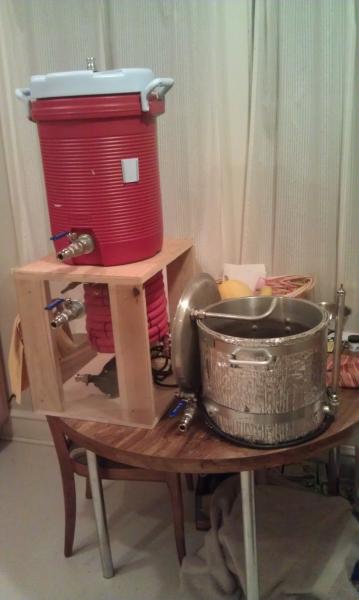BadWolfBrewing
Well-Known Member
Hello all,
I'm in the middle of a countertop brutus 20 build, and I finally broke down and did some math. I was looking for the power requirements to boil water and all I could find was the power requirements to raise water to 212 F. This is only half the story though, and not even the important half. The other part is called the latent heat of vaporization, essentially the energy required to turn water into steam. Here's the numbers I came up with:
The latent heat of vaporization of water (from wikipedia):
2257 kJ/kg
Lots of unit conversions...
(2257 kJ/kg)*(0.45 kg/lb)*(8.35 lb/g)*(0.28 Wh/kJ) = 2.37 kWh / gallon
The final unit, kilowatt-hour, is useful for us, because we usually measure boil off rate as a gallon per hour. For my system, doing 2.5g final batch size, I can assume something simple for now, like 0.5 g/h (although probably less in actuality). Putting that into the final equation,
(2.37 kWh/g) * (0.5 g/h) = 1.2 kW (rounded)
So, I need 1.2 kW to boil off a half gallon per hour. Larger batches will require higher boil-off rates, so just use the 2.37 kWh/gallon, multiplied by your expected boil off rate.
I'm trying to stick with a 1.5 kW element, due to old wiring in house. The breaker and GFCI outlet are rated for 20A, but the wiring sure as hell isn't. I rent, so I can't go tearing things up. This leaves me 300W to maintain 212 F once I'm at boiling temperatures, so I'd better insulate.
I'm a couple of weeks away from defending my PhD in mechanical engineering, so I have a fair amount of confidence in these numbers, but it is possible I did something wrong. I'm in controls engineering, not thermodynamics, and I haven't had one of those classes in years.
I just wanted to provide some more information for people trying to pick out their heating elements, and I haven't seen anybody show this yet. If it is out there on the forum already, my apologies.
I'm in the middle of a countertop brutus 20 build, and I finally broke down and did some math. I was looking for the power requirements to boil water and all I could find was the power requirements to raise water to 212 F. This is only half the story though, and not even the important half. The other part is called the latent heat of vaporization, essentially the energy required to turn water into steam. Here's the numbers I came up with:
The latent heat of vaporization of water (from wikipedia):
2257 kJ/kg
Lots of unit conversions...
(2257 kJ/kg)*(0.45 kg/lb)*(8.35 lb/g)*(0.28 Wh/kJ) = 2.37 kWh / gallon
The final unit, kilowatt-hour, is useful for us, because we usually measure boil off rate as a gallon per hour. For my system, doing 2.5g final batch size, I can assume something simple for now, like 0.5 g/h (although probably less in actuality). Putting that into the final equation,
(2.37 kWh/g) * (0.5 g/h) = 1.2 kW (rounded)
So, I need 1.2 kW to boil off a half gallon per hour. Larger batches will require higher boil-off rates, so just use the 2.37 kWh/gallon, multiplied by your expected boil off rate.
I'm trying to stick with a 1.5 kW element, due to old wiring in house. The breaker and GFCI outlet are rated for 20A, but the wiring sure as hell isn't. I rent, so I can't go tearing things up. This leaves me 300W to maintain 212 F once I'm at boiling temperatures, so I'd better insulate.
I'm a couple of weeks away from defending my PhD in mechanical engineering, so I have a fair amount of confidence in these numbers, but it is possible I did something wrong. I'm in controls engineering, not thermodynamics, and I haven't had one of those classes in years.
I just wanted to provide some more information for people trying to pick out their heating elements, and I haven't seen anybody show this yet. If it is out there on the forum already, my apologies.




